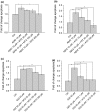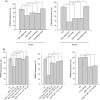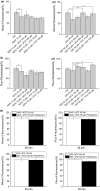Carbonic anhydrase inhibition selectively prevents amyloid β neurovascular mitochondrial toxicity
- PMID: 29873184
- PMCID: PMC6052473
- DOI: 10.1111/acel.12787
Carbonic anhydrase inhibition selectively prevents amyloid β neurovascular mitochondrial toxicity
Abstract
Mounting evidence suggests that mitochondrial dysfunction plays a causal role in the etiology and progression of Alzheimer's disease (AD). We recently showed that the carbonic anhydrase inhibitor (CAI) methazolamide (MTZ) prevents amyloid β (Aβ)-mediated onset of apoptosis in the mouse brain. In this study, we used MTZ and, for the first time, the analog CAI acetazolamide (ATZ) in neuronal and cerebral vascular cells challenged with Aβ, to clarify their protective effects and mitochondrial molecular mechanism of action. The CAIs selectively inhibited mitochondrial dysfunction pathways induced by Aβ, without affecting metabolic function. ATZ was effective at concentrations 10 times lower than MTZ. Both MTZ and ATZ prevented mitochondrial membrane depolarization and H2 O2 generation, with no effects on intracellular pH or ATP production. Importantly, the drugs did not primarily affect calcium homeostasis. This work suggests a new role for carbonic anhydrases (CAs) in the Aβ-induced mitochondrial toxicity associated with AD and cerebral amyloid angiopathy (CAA), and paves the way to AD clinical trials for CAIs, FDA-approved drugs with a well-known profile of brain delivery.
Keywords: Alzheimer's disease; acetazolamide; amyloid β; carbonic anhydrase inhibitors; methazolamide; mitochondria.
© 2018 The Authors. Aging Cell published by the Anatomical Society and John Wiley & Sons Ltd.
Figures






References
-
- Abramov, A. Y. , & Duchen, M. R. (2003). Actions of ionomycin, 4‐Br A23187 and a novel electrogenic Ca2 + ionophore on mitochondria in intact cells. Cell Calcium, 33(2), 101–112. - PubMed
-
- Abramov, A. Y. , Fraley, C. , Diao, C. T. , Winkfein, R. , Colicos, M. A. , Duchen, M. R. , & Pavlov, E. (2007). Targeted polyphosphatase expression alters mitochondrial metabolism and inhibits calcium‐dependent cell death. Proceedings of the National Academy of Sciences of the United States of America, 104(46), 18091–18096. 10.1073/pnas.0708959104. - DOI - PMC - PubMed
Publication types
MeSH terms
Substances
Grants and funding
LinkOut - more resources
Full Text Sources
Other Literature Sources

